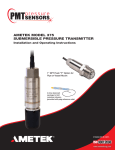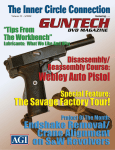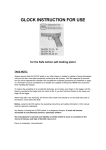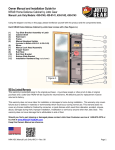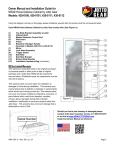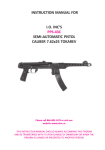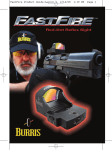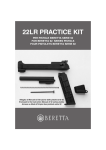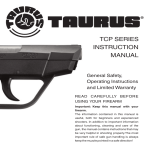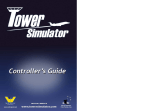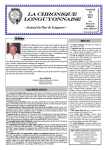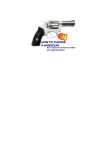Download Russian Rocket`s GoodLookingLoser Guide to Handguns
Transcript
1. Issue 1.0 - 11/29/2013 Russian Rocket (Author) Make or Break (CoAuthor / Editor) Russian Rocket’s Good Looking Loser Guide to Handguns Introduction Handguns are the staple of civilian self-defense. We can't carry a rifle or shotgun everywhere we go for a number of reasons. First and foremost is practicality, second is necessity, and third is regional laws. For the purposes of this guide, I will focus on handguns for defensive use in both the home and elsewhere. Modern handguns are divided into two main types: semi-automatic (by far the most popular in the U.S. today with civilians, law enforcement, and military) and revolvers. Revolvers are limited in capacity and difficult to reload under duress— however, they are easier to manipulate in the rare case of a malfunction or if the user’s hands are physically impaired. I personally prefer semi-autos for defense because it’s better to have extra ammo than no ammo. Also, you don’t always have the luxury of a safe escape route— nevertheless, I will cover revolvers in more detail later in this guide should you choose to get one for self-defense. I. Semi-automatic pistols A. Operation Semi-automatic pistols can either be hammer-fired or striker-fired. Hammer-fired pistols can use any one of the following action types: ● Single action (trigger performs one action: release the hammer onto the firing pin) ● Double action/single action (hammer is cocked as the trigger is pulled for the first time, and then the hammer is released when the trigger reaches the end of its pull; subsequent shots are single-action unless the weapon fails to fire, in which case it reverts again to double action) ● Double action only (the hammer cannot be cocked, and only moves while the trigger is being pulled) 2. Issue 1.0 - 11/29/2013 Striker-fired pistols, however, simply cut out the middleman (the hammer, which stands between the trigger and the firing pin). B. Sizes There are four classes of semi-automatic handguns based on size: full-size, compact, subcompact, and pocket-sized. The definition of each category tends to vary slightly between manufacturers, so there will be some slight overlap. That said, full-sized semi-autos generally have a barrel length of 4 inches or more, compacts tend to have barrels between 3.5 inches and 4 inches, and subcompacts usually have barrels shorter than 3.5 inches. Pocket pistols are a somewhat special category, and typically have barrels closer to 3 inches in length, or shorter. Pocket pistols are also much thinner and lighter and, until very recently, were not chambered in any full-power service cartridges, such as the 9x19mm Parabellum/Luger. i. Full-sized Full-sized semi-autos are ideal for both home defense and the range. Many people even concealed carry full-size pistols. Contrary to popular belief, packing a full-size handgun is perfectly feasible for most people so long as they appropriately conceal it in their clothing, 3. Issue 1.0 - 11/29/2013 which is what you should be doing anyway if you’re carrying. Weight is also an issue for many people. However, the perks of using a full-sized handgun are that you get the best accuracy, capacity, and power in the entire handgun category. If you’re okay with compromising on any of these aspects, keep reading. ii. Compact Compact semi-autos are considered by most gun-owners to be the ideal for concealed carry while still providing more than enough firepower for home defense and plain old range use. They strike an excellent balance of reduced size and weight with still-significant capacity, accuracy, and power. In fact, I wouldn’t necessarily consider this category a compromise. Compacts tend to fit a wider range of hand sizes than most full-size semi-autos. iii. Subcompact Subcompacts are where the real compromising starts. First and foremost, they are harder to control than the above categories. The greatly-reduced surface area of the grip means you will have more difficulty holding the weapon while firing. In addition, reduced weight means you feel the recoil more, because there is less mass to absorb the firing energy. The reduced barrel length of subcompacts also contributes to increased recoil. On top of that, the terminal ballistic performance of the bullets you fire from a subcompact handgun will be drastically reduced due to the lack of barrel length. However, some manufacturers make defensive loads that are optimized for these shorter barrels. I will cover that in more detail later. Finally, with subcompacts, you’re looking at reduced accuracy and range. I’m sure you can tell by now that I don’t like them at all, but some people do. Your mileage may vary. My advice is to go to a gunshop near you and try out a variety of models before you decide on one to purchase. Either find a range that lets you rent these guns, or make friends with someone who owns one or more. iv. Pocket Pocket pistols are the final compromise short of not carrying a gun at all. The upside is that you can easily conceal one of these and carry it around all day with minimal discomfort, but they have very limited capacity, fairly poor accuracy, limited power, and offer far less control. This is where the saying “it’s better to have a gun than no gun at all” really comes from. Most pocket pistols are chambered in weaker calibers like .32 ACP and .380 ACP, but recently some have begun to appear in 9x19mm and even .40 S&W. However, the short-barrel performance caveat from the previous section applies even more here. C. Brands and prices (New) Most brands of semi-auto pistols will stay within a certain price bracket, but some produce models that cover a wide range of costs. Those models will be noted in this guide. This section of the guide will cover examples of new guns, as opposed to used guns, including police trade-ins and military surplus. I’ll cover those in a separate post. However, if you are 4. Issue 1.0 - 11/29/2013 new to guns, I recommend starting with a new one. This has the massive advantage of having a warranty behind your gun should something go wrong. However, if you must get a used gun, which is still perfectly okay, you should have it inspected by a gunsmith before you fire it. i. Shit tier ($150 or less) Any new handguns that are below $150 are probably shit. Examples include brands like Jennings, Raven, Lorcin, Davis, and others. If you’re in danger, broke, and you desperately need a gun in one hell of a hurry, maybe you could flirt with the idea of getting one of these, but then again, you probably shouldn’t. This category is also known as “Saturday Night Specials”. ii. Ultra-low tier ($150-$200) This is a fairly narrow category as far as new guns go. Here you’re looking at brands such as Hi-Point. While their guns are pretty crappy and are akin to giant bricks, the company has excellent service and stands behind their product. While their guns may not work when you initially buy them, the company is willing to repair them until they’re fixed if you send them back. Note, this level of customer service does not apply for most manufacturers in this tier. 5. Issue 1.0 - 11/29/2013 iii. Low tier ($200-$400) Now we’re getting somewhere. Here are some very good deals in new guns, and some not-so-good. Here’s a list of manufacturers and their products that fit in this category: ● ● ● ● ● ● ● ● Zastava (Serbia): M57 Tokarev, M70A Tokarev, M88A, CZ999 Walther (Germany): PK380 Kel-Tec (USA): P-32, P-3AT, P-11, PF-9 Bersa (Argentina): Thunder 380 Smith & Wesson (USA): SD9, SD40, Sigma Ruger (USA): LCP Beretta (Italy/USA): Tomcat, Bobcat, PICO, Nano Taurus (Brazil): PT809, PT22, PT738 Note: many—if not most— of the guns in this tier are pocket pistols. Beware: I cannot, in good conscience, recommend Taurus as a brand, especially as of late 2013. Their quality control has gone down the shitter in the past decade, and it appears to be continuing to spiral down that way. iv. Low-mid tier ($400-$500) 6. Issue 1.0 - 11/29/2013 This is where things get interesting. The low-to-mid tier includes some of the best deals in new handguns on the market, but you don’t necessarily need to stop here unless your budget is tight. An extra $100 will put you in the solid mid-tier and, more than likely, net you a better shooting experience. ● ● ● ● Ruger (USA): SR series Rock Island Armory (Philippines): 1911 series Smith & Wesson (USA): M&P Shield Taurus (Brazil): PT92 and PT1911 (probably the only decent semi-auto pistols that Taurus makes) ● American Tactical Imports (Philippines): FX45 1911 ● Auto Ordnance (USA): 1911A1 ● Walther (Germany): PPX v. Mid-tier ($500-$750) The mid-tier commands the lion’s share of the semi-auto pistol market. You’ll find most of the major brands here and the majority of the best reside here. ● ● ● ● ● ● ● ● ● ● ● ● Glock (Austria/USA): 17, 19, 20, 21, 22, 23, etc. (in other words: their entire lineup) Beretta (Italy/USA): 92FS, M9, Px4 Storm, 92A1, 96A1 SIG-Sauer (Switzerland/Germany/USA): P250, SP2022 CZ (Czech Republic): CZ 75 series, CZ P07 Smith & Wesson (USA): M&P series Stoeger (Turkey): Cougar series Remington (USA): 1911 R1 Kahr Arms (USA): K series, P series FN Herstal (Belgium): FNP series, FNX series, FNS series Walther (Germany): PPK, PPQ, P99, PPS Magnum Research (USA/Israel): Baby Eagle II Springfield Armory, Inc. (USA, in cooperation with IMBEL of Brazil and HS Produkt of Croatia): XD series, XDM series, 1911-A1 7. Issue 1.0 - 11/29/2013 vi. Upper tier ($750-$1300) The pistols in this tier perform about as well as the ones in the mid tier, but cost more. In this category you’re mostly looking at name-brand recognition or other special features. Not to say that most of the guns here are not excellent, but there’s a question of necessity that you’ll have to keep in mind for yourself as you make your choices. ● ● ● ● ● ● Heckler & Koch (Germany): HK45, P30, USP, P2000 SIG-Sauer (Switzerland/Germany/USA): P220, P226, P227, P229 Colt (USA): 1911 series (the original) Browning (USA/Canada, in cooperation with FN Herstal of Belgium): Browning Hi-Power Para Ordnance (Canada): 1911 series Kimber (USA): 1911 series vii. Semi-custom and beyond ($1300+) 8. Issue 1.0 - 11/29/2013 From here on out, the field is dominated by the model 1911 pistol, but you may still find the occasional exotic handgun that does not fall into that category. Brands listed below are known primarily for 1911s unless otherwise noted. ● ● ● ● ● ● ● ● Les Baer Custom (USA) Wilson Combat (USA) Ed Brown (USA) Nighthawk Custom (USA) Colt’s Custom Shop (USA) Springfield Armory, Inc. Custom Shop (USA) Kimber Custom (USA) Heckler & Koch (Germany): Mark 23 Note: the Magnum Research/IWI Desert Eagle is not listed here because it is not a defensive handgun. II. Revolvers Now, as promised, revolvers— giddy up, cowboy! There isn’t really a set standard of sizes for these, so I’ll sort them by barrel length. Typical revolvers will come with barrel lengths anywhere from just under 2 inches, to 4 inches, to 6, and beyond. 4 inches was the standard for the final half-century or more that service revolvers were still, well, in widespread service. 2 inches is the most common length for snub-nosed revolvers, which are what most revolver users carry now. 4-5 inches is about the optimum range of barrel length; it balances ballistic performance and maneuverability in a revolver. 6 inches is pushing it, especially on the draw. You will only be able to carry a six-incher concealed in a shoulder holster (sorry about any aspirations you had with that new Bathmate). 9. Issue 1.0 - 11/29/2013 Current, active manufacturers of double-action, defensive revolvers include: ● ● ● ● ● Smith & Wesson (USA) Ruger (USA) Charter Arms (USA) Armscor (Philippines) Taurus (Brazil) (their revolvers may be more reliable than their semi-autos, but still, beware) ● Rossi (Brazil, made by Taurus) Of these, Smith & Wesson and Ruger are the best without question. S&W emphasizes higher quality, but Ruger revolvers are built like tanks and will serve you just as well, and at a much lower price. Colt used to make fantastic double-action revolvers, but ceased all production of them by the mid-2000s. 10. Issue 1.0 - 11/29/2013 III. Ammunition A. Cartridges Cartridge, or more simply, “round”, describes the whole object that you load into modern firearms, to be fired. For handgun cartridges, it consists of the case, the primer, the powder charge (propellant), and the bullet. The case can be made from brass, aluminum, nickel-plated brass, or steel. Steel cases that are worth a damn always have some sort of coating, whether it be lacquer, polymer, or copper. The metallic cartridge has been the standard delivery system for large chunks of lead since about 1870. The primer is mounted in the center of the base of the cartridge case. When struck by the gun’s firing pin, the explosive charge in the primer detonates and is channeled, through a port in the case, inside to the powder charge, which then ignites. The gases generated in this small explosion propel the bullet out through the barrel. i. List of cartridges ● .22 Long Rifle: Not a defensive cartridge. This has been the global standard target-shooting round for many generations, and used to be much cheaper. Since the end of 2012, though, political crises and the resulting panic-buying have disgustingly inflated the price. It has yet to go down, as we near the end of 2013. ● 5.7x28mm: Developed by FN Herstal for the Five-seveN pistol and P90 submachine gun. It was intended to punch through standard body armor of the early 1990s, but that’s the only thing it’s good at doing. It doesn’t do much actual damage, and on top of that, the armor-piercing rounds for it are generally not available to civilians in the U.S. Fun to shoot because of its low recoil and high-capacity, but it’s little more than a glorified .22. Ammo is scarce and expensive. I would not recommend this for defense. 11. Issue 1.0 - 11/29/2013 ● .25 ACP: Once was a last-ditch defensive cartridge, but honestly, it’s practically worthless. You might be better off with a baseball bat. Not many firearms are made in this caliber anymore. Good riddance. ● .32 ACP: By most standards, this round is still sub-par, but it can do in a pinch, provided you use the right ammo and shoot *very accurately*. Works pretty well in backup guns, though. ● 7.62x25mm Tokarev: Soviet standard pistol round from 1933 to the mid-1950s. Carried on in service for another 30 years or more in some other Communist-bloc countries. Great for getting through soft body armor, but its penetrative power is about all it has going for it. Ammo is becoming very scarce in this caliber, especially decent defensive loads. ● .380 ACP: Offers some improvement over .32 ACP, but still lacking. See the caveats for .32 ACP. Many people consider this the bare minimum for a defensive cartridge. Many others disagree. Your mileage may vary, etc. Works very well for a backup gun. ● 9x18mm Makarov: I consider this the bare minimum for a primary defensive handgun. Ammo is plentiful and quite affordable, as are the Eastern-Bloc military-surplus guns that fire it. ● .38 Special: The most popular revolver cartridge of all time, hands-down. Being made for revolvers, this is also one of the most flexible cartridges ever, as far as loads go. I’ll go into more detail on this in the next section. ● 9x19mm Parabellum (aka 9x19mm Luger, or simply 9mm): The worldwide gold standard for handguns. Period. Introduced in 1901, the 9mm has arguably seen the most interest, research, and development of any handgun cartridge over the past century, especially once the United States took a belated interest in it in the mid-1980s. 9mm offers the highest capacity of any defensive cartridge in semi-auto pistols with double-stack magazines (up to 18 rounds in flush-fitting magazines in certain models, and up to 20 in just-slightly-extended magazines). 9mm also offers more-than-adequate power, accuracy, and penetration. All around, I feel it is the best balance. That said, it’s not the be-all-end-all of handgun cartridges. There is simply no such thing. Some people shoot .45 better than they shoot 9mm. Your mileage may vary. Ammo is plentiful and cheap. ● .357 Magnum: This revolver cartridge, a lengthened and strengthened version of the .38 Special, was the gold standard in defensive revolvers for decades. That is, until people stopped giving much of a shit about revolvers. Since the mid-1980s, development of bullet technology for .357 Magnum has lagged, and the snubnose revolvers in common use today (instead of longer service revolvers) do not offer enough barrel length to make adequate use of the .357 Magnum. Still, if you really like revolvers and use a full-sized service model, it’s a well-proven option. ● 10mm Auto: Created in the ‘80s, this is one bad motherfucker. The most powerful cartridge designed for mass-produced semi-autos. However, that doesn’t make it better than the rest. Power is relative, and when you’re talking about handguns, it’s never enough to reliably put a man down in his tracks without proper shot placement. 10mm is no exception. If you can control 10mm well and wish to use it for defense, more power to you. Most people, however, would be better served by a different cartridge. 12. Issue 1.0 - 11/29/2013 ● .40 Smith & Wesson (aka .40 S&W, .40 Short & Wimpy, amongst other derogatory nicknames): Created in the early ‘90s for paper-pushing pansy FBI agents who couldn’t handle the power of the 10mm Auto, and as a marketing ploy. It’s been the standard in U.S. law enforcement circles since then, but recently there’s been quite a bit of shifting back to 9mm, a trend which is likely to continue. It offers no substantial improvement over 9mm, yet it reduces the ammo capacity of the gun due to its larger diameter. ● .357 SIG: Basically .40 S&W with a case bottlenecked to take a 9mm bullet instead. The result is a bit more power. Same capacity as .40 and 10mm, but again, since we’re talking handguns, not enough improvement. .357 SIG is also not necessarily pleasant to shoot. ● .38 Super Auto: Not to be confused with .38 Special, this is a cartridge for semi-autos. Popular in places like Mexico, where civilians are strangely prohibited from owning firearms that are chambered in “military” calibers. It’s also popular in competition. You won’t find many good defensive loads for this anymore, though. It’s somewhere in between 9mm and .357 SIG in performance. ● .45 Automatic Colt Pistol (.45 ACP): The American legend. Designed in 1905, this is an outstanding choice for a defensive handgun cartridge. When you ask what the best pistol cartridge is, the vast majority of people will say either 9mm or .45 ACP. These two have been neck-and-neck since their introduction. Truth is, you’d be well-served by either. Pick which one you shoot best, and can afford. .45 ACP is quite a bit more expensive than 9mm. ● .45 Glock Automatic Pistol (.45 GAP): Nope. Let it die. Please. B. Loads Loads center around two things: the bullet and the powder charge behind it. The weights of both are measured in grains. The amount and type of powder determine the pressure generated and the duration of the ignition. All these factors, plus the weight of the bullet, should be considered along with the barrel length in order to optimize performance of the bullets when both in the air and inside the target. i. Bullets a. Practice bullets ● Lead round nose or Lead flat nose: Just a chunk of lead, usually with some kind of lubricant covering to keep it from leaving lead residue in the gun, which can be difficult to remove. ● Plated: A chunk of lead with a thin copper plating around it. ● Full Metal Jacket (FMJ): A chunk of lead with a thicker “jacket” of either copper, brass, or copper-plated steel (known as a “bimetal jacket”). The base of the bullet is exposed lead. This is the industry standard for target rounds. ● Total Metal Jacket (TMJ): Same as FMJ, but with the jacket covering the entire bullet. ● Lead wadcutter: a flat-ended, cylindrical lead bullet that is only really used in revolvers. ● Lead semi-wadcutter (LSWC): Similar to lead flat nose. 13. Issue 1.0 - 11/29/2013 b. Defense bullets (aka “social ammo”, anti-personnel, etc.) ● Jacketed Hollow Point (JHP): similar to FMJ in construction, but with a hollow cavity for a tip, and often some lengthwise cuts in the jacket. This bullet is designed to expand violently upon penetrating a target, causing maximum damage. These are not recommended for cartridges weaker than 9x19mm, as those do not meet the FBI’s 12-inch minimum ballistic-gelatin penetration standard. ● Bonded Jacketed Hollow Point: same as regular JHP, except the jacket is chemically bonded to the lead core. This helps the bullet remain in one piece while it is doing its work inside the target, thus ensuring it penetrates to its goal (i.e., a vital organ). Bonded JHP is ideal for when your target is hidden behind certain light barriers, such as wallboard, car doors, auto glass, etc. ● Lead semi-wadcutter hollow point (LSWCHP): same as the LSWC, but with a hollow cavity in front. This aids expansion and maximizes damage to the target. This was the FBI’s (and just about everyone else’s) preferred bullet while revolvers were still in vogue. It still is the best for .38 Special. There are a few other more exotic types of bullets in the market, but these are by and large what you will find for most calibers, and really are the best options. ii. Overpressure For a lot of calibers, especially 9mm, .45 ACP, and .38 Special, there are loads marked as +P or +P+. +P means the case is loaded with a specific amount of extra powder and is thus overpressured within the standards set for that category. +P+ means the cartridge exceeds even the former’s standards for overpressure. A lot of modern handguns are rated for +P, but make extra sure yours is rated as such before using +P ammo in it. The user manual will usually tell you whether it is safe to use or not. That said, it’s best to stick to standard-velocity ammo for practice purposes. +P will only wear out your gun faster. The advantage, however, of using +P in certain cartridges like 9mm is that it can increase the terminal ballistic performance of the bullet, but that is not always the case. +P+, on the other hand, should be fired very sparingly. Since it does not conform to any standards, firearms cannot be rated for it. There is an exception to this: .38 Special +P+ may be fired in handguns chambered for .357 Magnum worry-free, so long as it is factory-loaded ammunition that you know is safe to fire at all (as opposed to unverified handloaded ammunition). iii. Examples of effective defensive loads by caliber ● .32 ACP, .380 ACP, 9x18mm Makarov: Standard FMJ is recommended due to poor penetration in other forms. ● .38 Special: 158-grain LSWCHP +P, 125-grain JHP +P, 115-grain JHP +P+ 14. Issue 1.0 - 11/29/2013 ● ● ● ● ● 9x19mm Luger: 124-grain JHP +P, 147-grain JHP, 115-grain JHP +P .357 Magnum: 125-grain JHP, 158-grain JHP .40 S&W: 165-grain JHP, 180-grain JHP 10mm Auto: 165-grain JHP, 180-grain JHP, 200-grain JHP .45 ACP: 230-grain JHP Brands include Federal (HST and Hydra-Shok), Speer (Gold Dot), Winchester (Ranger), Hornady, Remington, Corbon, Buffalo Bore, Underwood, and Double Tap. Conclusion So, there you have it. A dry run on handguns— Hail to the King, Baby. — by Russian Rocket and Make or Break — As part of the Good Looking Loser Community. http://www.goodlookingloser.com/ http://www.gll-getalife.com/















